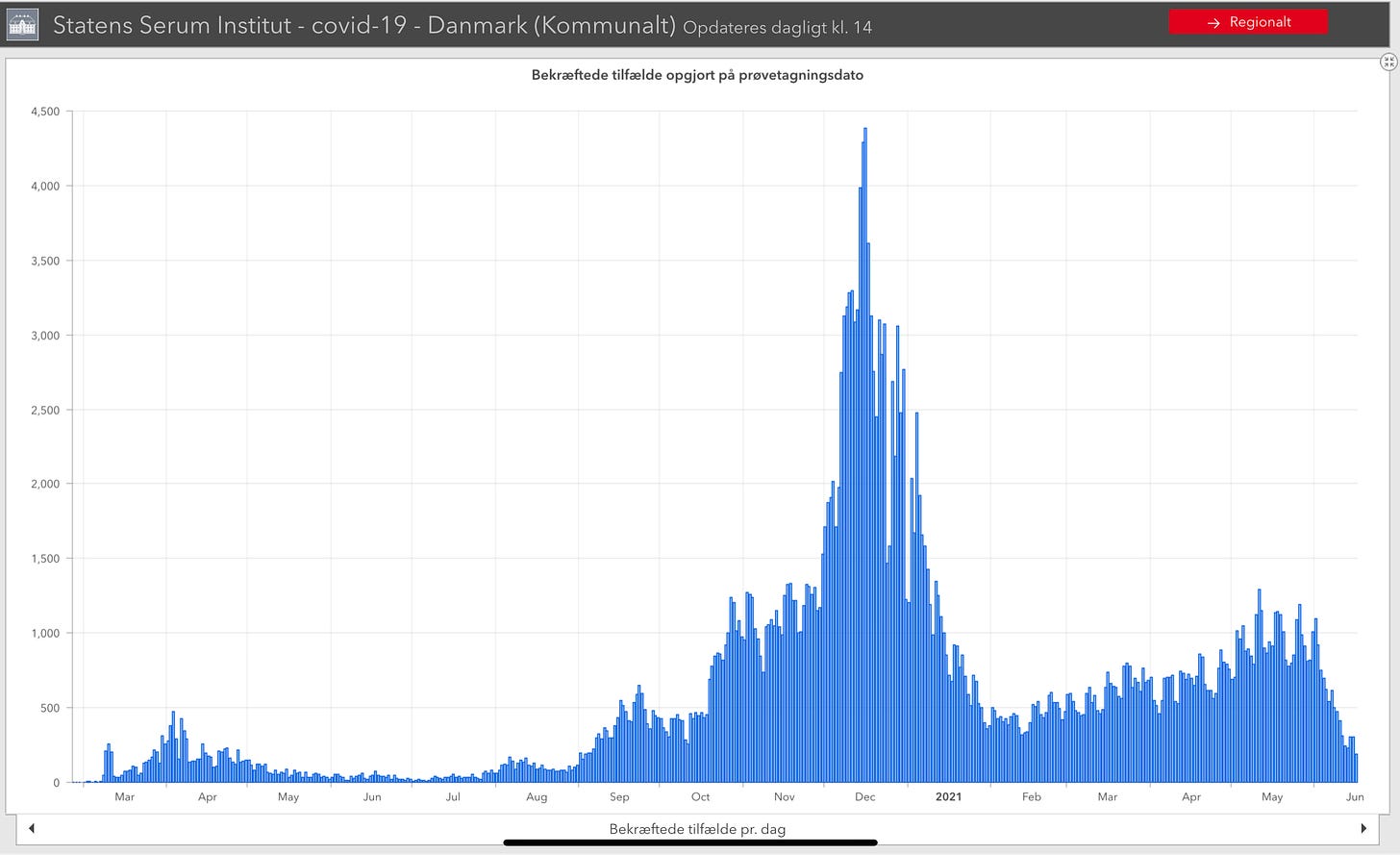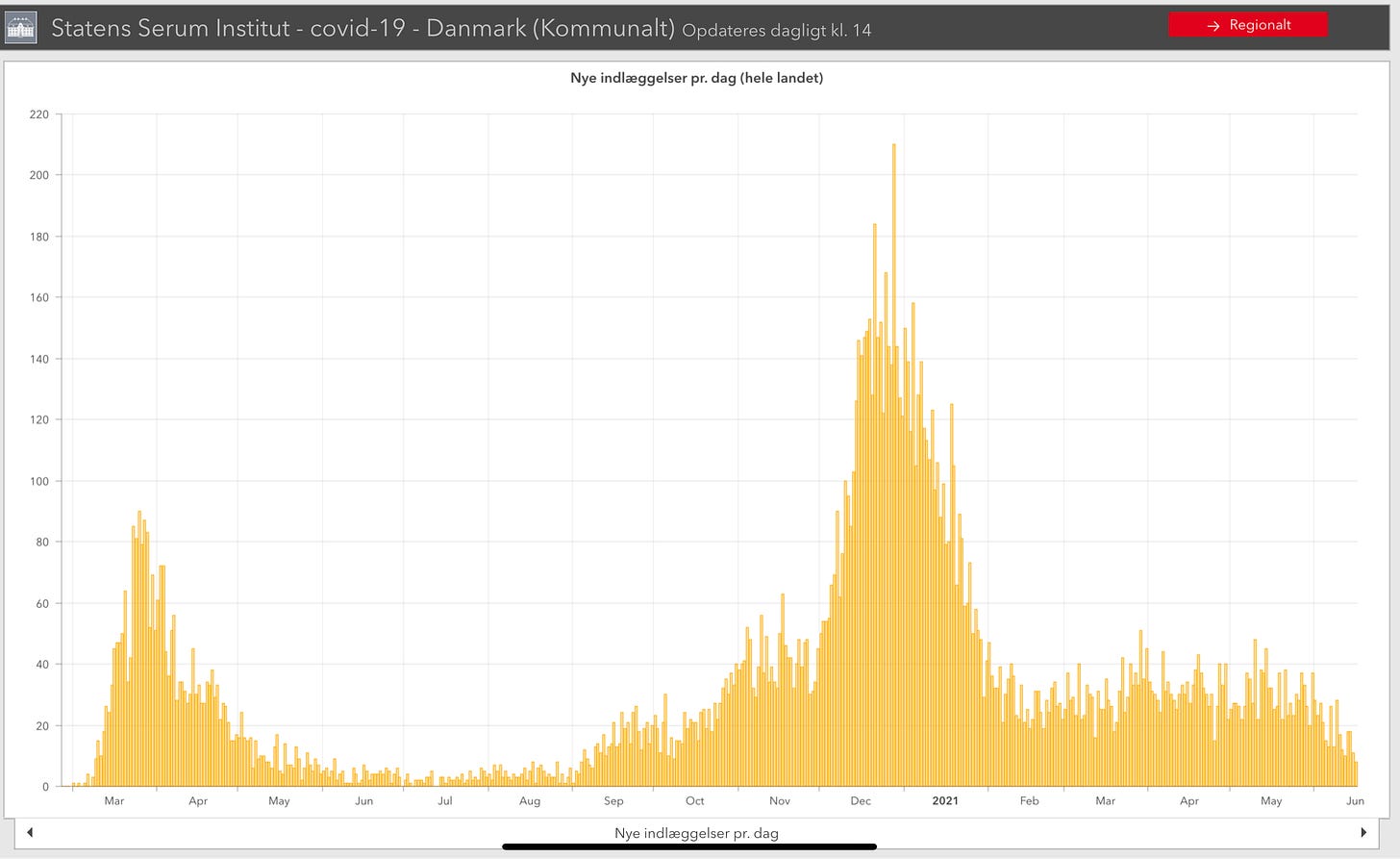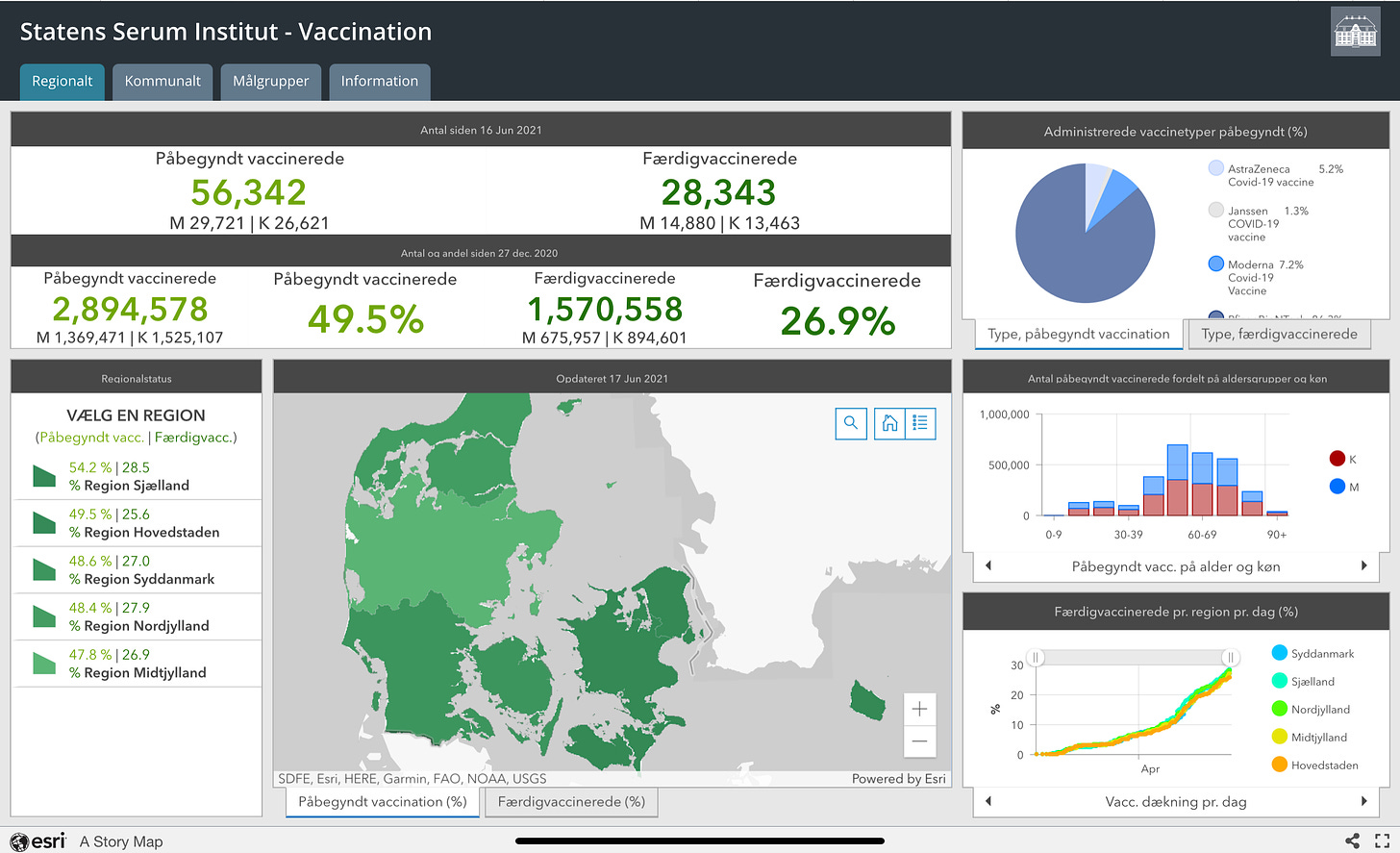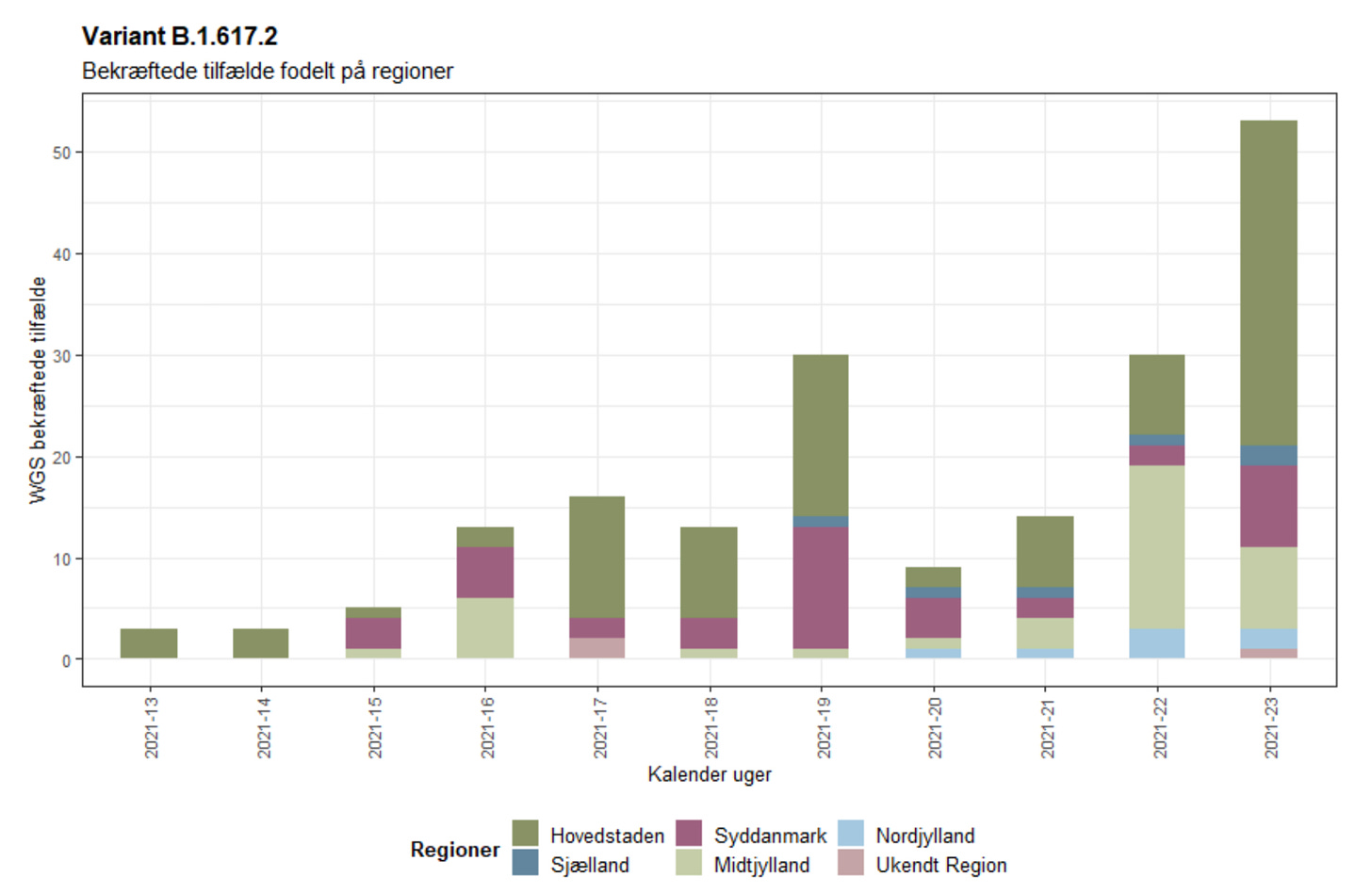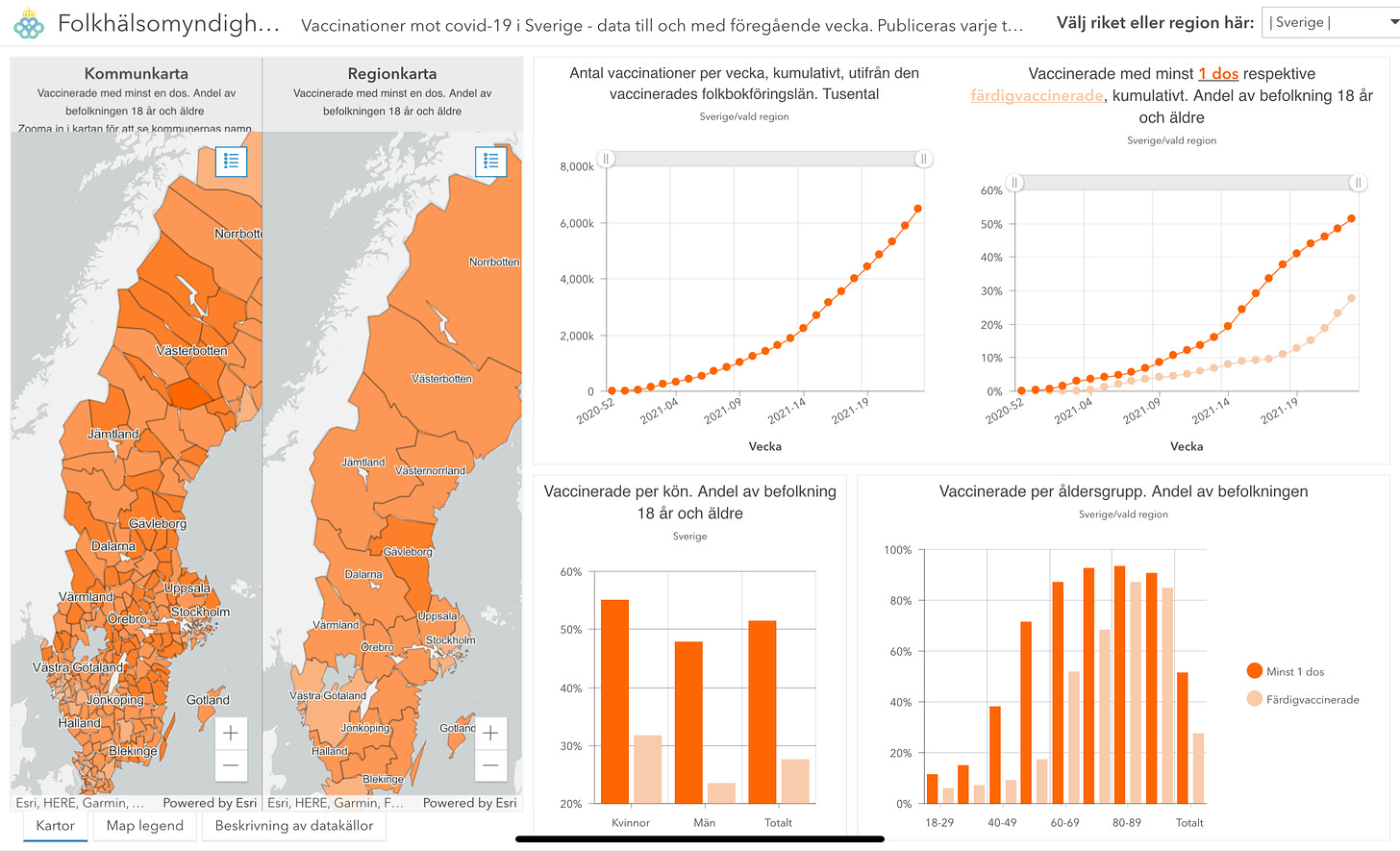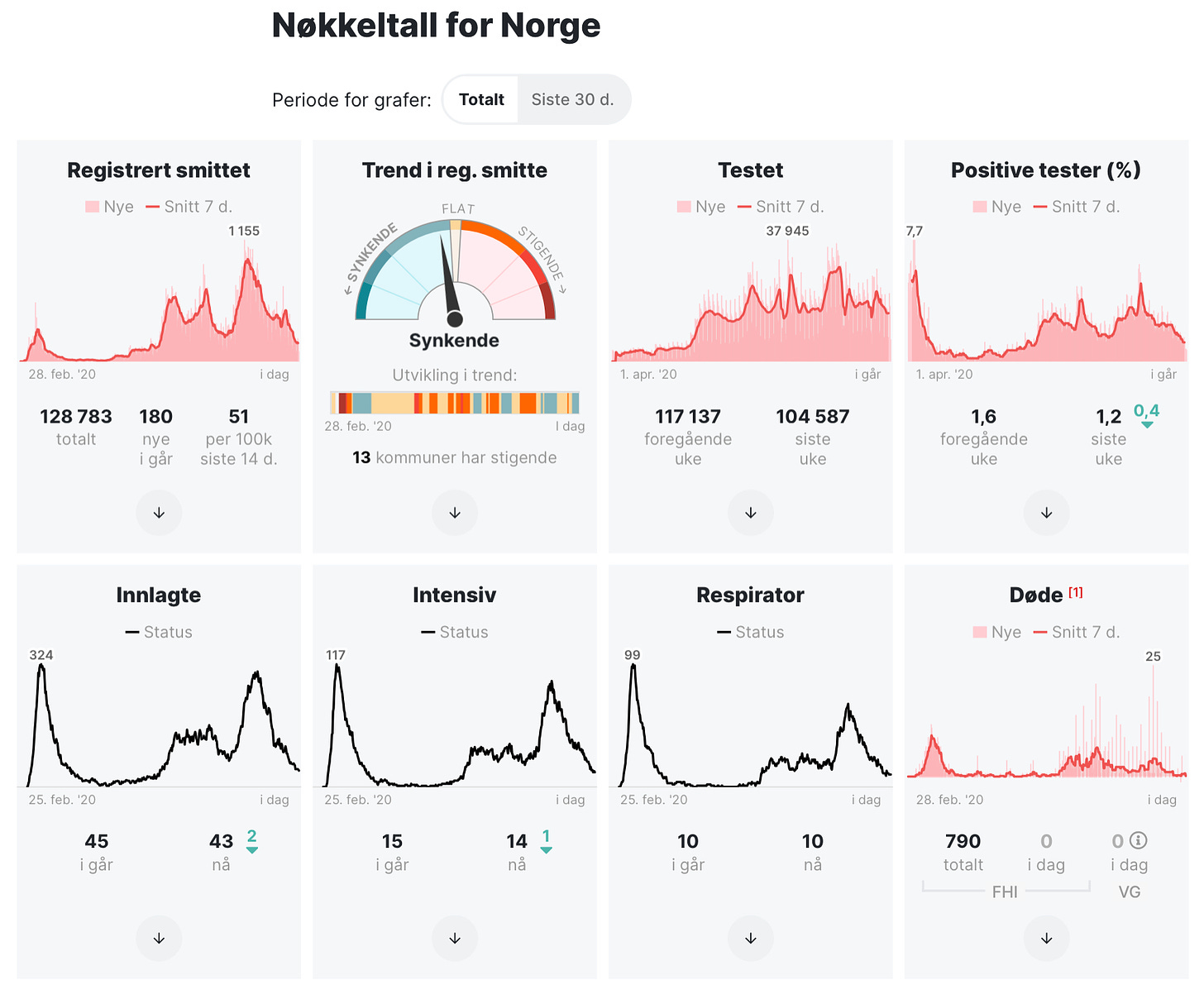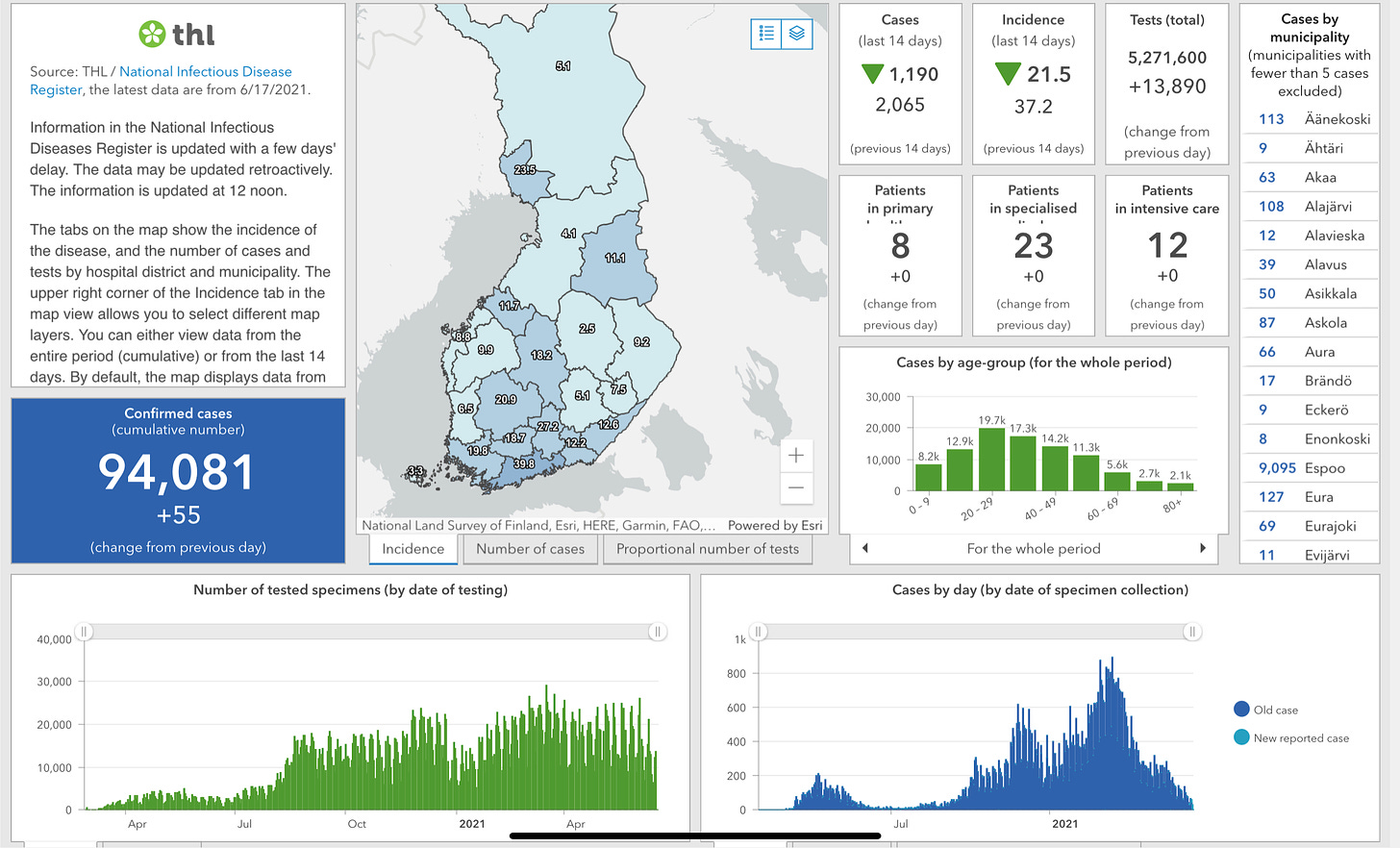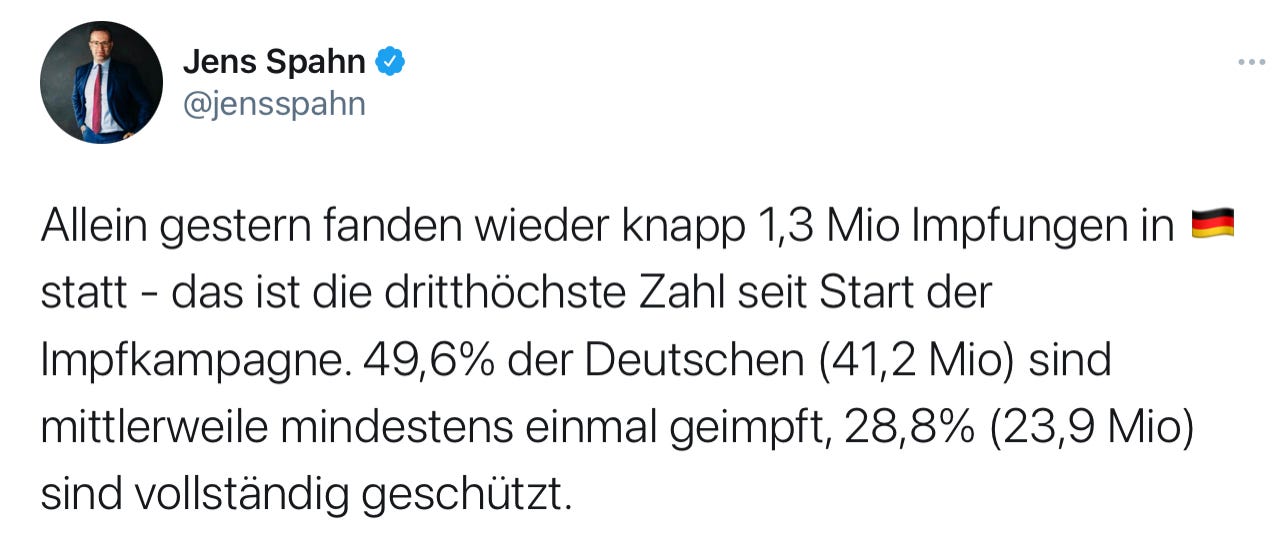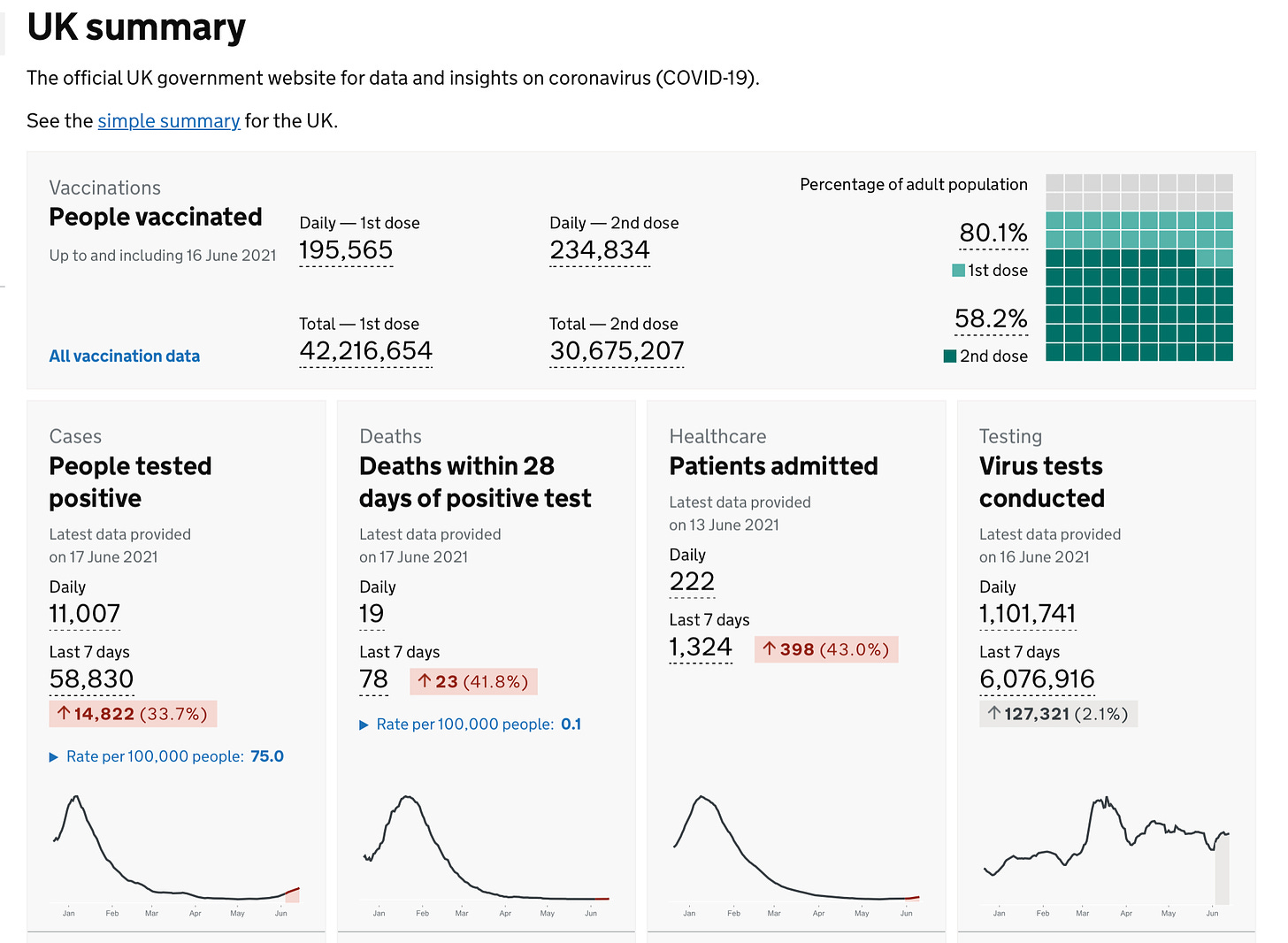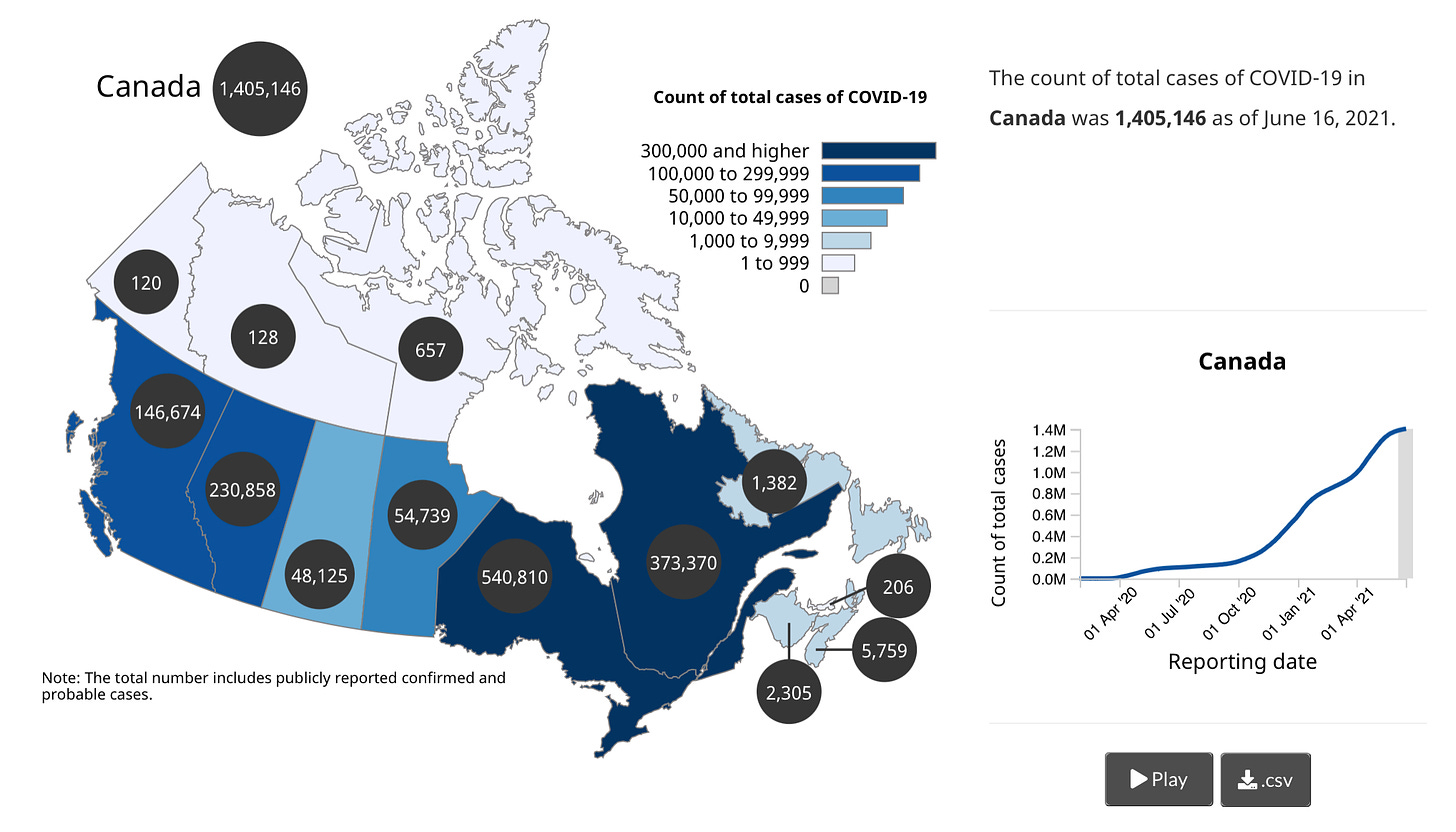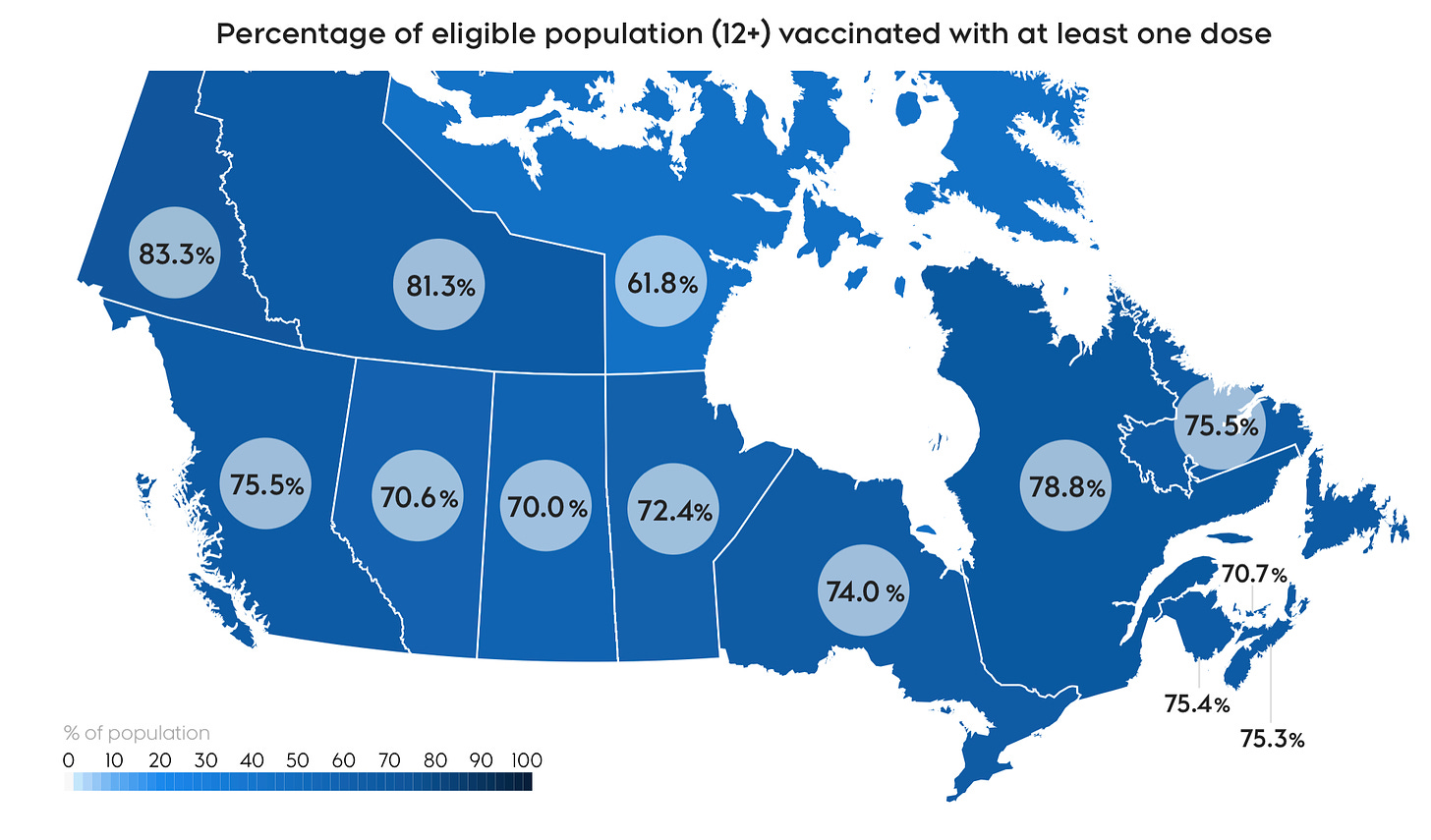🇩🇰
The Danish National Health Board is now recommending that adolescents between the ages of 12 to 15 years old be vaccinated against the coronavirus. Currently, only the Pfizer/BioNTech vaccine has been approved for use in Europe among adolescent children.
Health Board Director Søren Brostrøm:
“We have reviewed data and assess that the Pfizer/BioNTech vaccineis both very safe and very effective in 12-15 year old children. Although we have high support in the current target groups, which include approx. 83% of the population, we also believe that an expansion of the target group to the 12-15-year-olds is necessary to ensure even greater immunity in the population, and thus ensure control of the epidemic in Denmark. We need this before we enter the next winter season in Denmark, also in light of the fact that more infectious virus variants can emerge. And then we need it so that we can protect unvaccinated people and people who do not have the full effect of the vaccine from serious illness.”
Brostrøm added:
“When we have finished vaccinating those 16 years old and up, we may have a community immunity of around 60-65%. Add to that those who are under 16 and have had the disease. Then it's maybe 70%community immunity. Then the question is whether it is sufficient to maintain epidemic control. The answer is that it is probably not enough. This is the background for our recommendation.”
The plan to inoculate children as young as 12 will mean another delay for the vaccination calendar. The health board says the vaccination schedule for adolescents will be announced after the summer holiday. But in today’s press conference officials already noted it likely won’t begin until September. That is the month they had targeted to get everyone who wants a vaccine at least one dose.
Other EU countries have already started vaccinating children, including Germany, Austria, Estonia, Italy, Lithuania, and Poland. France and Spain are set to start in the next few months.
-
Denmark is reporting 331 new COVID infections and one more coronavirus death in the last day.
Yesterday there were 438,296 total #COVID tests done, 92,855 PCR and 345,441 rapid, for a (PCR only) positivity percentage of 0.35%.
COVID hospitalizations (84) continue to fall (-9) while the number of infected people in an ICU (19) also inched down (-1) of those the number on a ventilator (15) edged up (+1).
The Danish National Health Board says as far as hospitals are concerned, the COVID emergency is over. It says while hospitalizations in May floated around 150 patients this month, hospital numbers have fallen off of a cliff. Currently, there are fewer than 100 infected people in hospital, with the number in an ICU under 20.
Deputy Director Helene Probst:
“It is clearly a result of the fact that our elderly and most vulnerable have now been vaccinated. Vaccination protects against COVID and the risk of getting a serious disease course with the need for hospitalization. We are now beginning to see a direct effect of the fact that close to half of the population has started the vaccination process. We are seeing declining infection rates and declining hospitalizations, and this is a really gratifying development as we near the summer holidays.”
Probst says she anticipates hospitalizations will continue to drop.
"We expect a continued decline in the number of admissions, and we estimate that more of the patients who have a positive test for COVID at admission will be admitted for another reason."
Danish hospitals ended COVID emergency operations at the beginning of June. Coronavirus patients are now treated within the normal operations of a hospital.
-
On the vaccination front to date, 2,894,578 1st dose vaccinations (49.5% of the population) have been administered while 1,570,558 people (26.9%) are now fully vaccinated.
Yesterday there were 84,685 total vaccinations done.
-
On the variant front, today’s reports says the number of Delta variant cases in Denmark has grown to 189. The number of cases is creeping up by a few here and there, every update as opposed to any massive explosion. So that is a positive.
There are now 354 confirmed infections involving the further mutated Alpha variant (B.1.1.7) that has developed the E484K, or so called escape, mutation.
-
The Staten Serum Institut is warning about scam text messages being sent out. The message purport to be from the SSI and ask you to clink a link. The agency says they do not send out test messages and that is a phishing attempt to scam your personal information. Do not click the link, just delete the text message.
-
Despite the COVID pandemic, the number of blood donations in Denmark increased last year. The Danish Agency for Patient Safety’s annual report shows there 293,722 blood donations in Denmark last year, an increase of 4% from 2019’s 282,480. Last year, there were 129,284 total blood donors.
-
A new report from the Staten Serum Institut has found that the pandemic has spurred more municipalities to increase hygiene initiatives. Before the pandemic, less than half of Denmark’s 98 municipalities had met hygiene standards. Now, the SSI says the number of compliant municipalities has grown to 62.
The SSI says there have been clear benefits on both ends of the age spectrum. Its analysis shows that there were fewer COVID infections among nursing home residents in municipalities that had instituted hygiene best practices than those who didn’t. The same was found for children, where there were fewer absences due to sickness among students in grades 0-6 in municipalities instituting good hygiene practices than those who weren’t up to snuff.
🇸🇪
No updated coronavirus stats from Sweden today due to its ongoing SmiNet database woes.
On the vaccination front to date 4,290,143 1st dose vaccinations (52.4% of adult pop) have been done while 2,381,603 people (29.1%) are fully vaccinated.
Swedish Health Officials held a press conference today to update the COVID variant situation after Delta variant outbreaks in two regions. The Public Health Agency says the number of confirmed Delta variant infections has grown to 207. That is up from 81 cases identified as of June 10. It is unclear how exact the assessment, considering weeks of reporting problems due to the SmiNet database issues. The database, which is essential for the reporting of COVID cases, remains offline, as it has been since Sunday.
Another issue, reported by TV4 is the glacial pace of sequencing positive tests to screen for variants. In some cases, the turn-around time has been as high as six weeks. This resulted in at least one region not identifying Delta variant growth until it was too late. The arrival of the concerning variant prompted the Swedish Health Agency, as of June 1 to switch from random screening of positive tests to sequencing all positive results.
-
Region Stockholm says it is unable to update the number of infections and any fatalities due to the ongoing SmiNet situation. Currently, the region says there are 21 COVID patients in ICU, 46 in geriatrics and emergency hospitals, for a total of 67 total coronavirus patients. To date, there are 983,159 people in the region with one vaccine dose and 472,857 who have had both.
-
The Swedish Public Health Agency expects schools to return to normal with all students back in class after the summer holidays are over. That said, it also adds, that schools have to work hard to put in preventive infection measures and be prepared to deal with any outbreaks.
Department Head Britta Björkholm:
“The mental health of children and young people has been negatively affected during the pandemic. Physically being in school is important for learning and acquiring knowledge, and is also better for their mental health both in the long and short term.”
The agency says schools should avoid large gatherings, make sure spaces are well ventilated, encourage good hygiene, and any students with COVID symptoms must stay home.
-
A survey from Statistics Sweden has found that seven out of ten students aged 11, 13, and 15 years old were worried about the pandemic. Of those, 22% admitted to be extremely concerned. The survey involved 899 students across 42 different schools, found most students were worried about older members of their family getting sick. Statistically, more girls were stressed out about it than boys. Very few reported any impact on their studies rather, their social lives, usual activities, and ability to visit their grandparents were most impacted.
🇳🇴
Norway has added 182 infections and had no new corona deaths since yesterday’s update.
COVID hospitalizations (43) dipped (-2) ICU numbers (14) are down (-1) ventilator numbers (10) are unchanged.
To date 38.38% of Norwegians have one vaccine dose and 26.10% have had both.
-
The Norwegian Medicines Agency is closely following reports of inflammation of two parts of the heart that may be linked to COVID vaccines. The agency says with over two million people receiving at least one vaccine dose it has 42 reported cases of pericarditis and myocarditis. It says as of this report “most patients are reported to be improving.”
It says there are 35 reports of pericarditis (swelling of the sac around the heart).
29 were after vaccination with Pfizer/BioNTech
five after Moderna
one after AstraZeneca
There have been seven reported cases of myocarditis (swelling of the heart)
six reports after vaccination with Pfizer/BioNTech
one after Moderna
Chief Physician Sara Viksmoen Watle:
“We monitor all cases of pericarditis and myocarditis reported after vaccination. It has not been clarified whether there is a connection, but this is now being investigated both in Norway and at European level. It is important that people who get new and persistent shortness of breath or chest pain see a doctor regardless of whether they have been vaccinated or not.”
The institute says both conditions are relatively rare and occur more often in men than in women, and are more common in younger adults and adolescents.
In Europe, the incidence of these diseases is estimated at between 1 to 10 per 100,000 people per year. Most cases of pericarditis or myocarditis are mild and do not require treatment, but a few may require hospitalization.
-
The Norwegian Institute of Public Health is reporting that the use of antibiotics and cough and cold medication dropped significantly last year. For children four years old and younger, there was a 40% decrease in antibiotic use. For those over 70 the drop wasn’t nearly as significant, dropping by just 7%. Overall, year-to-year sales of antibiotics dropped by 7.4%. The agency says the pandemic with increased hygiene, social distancing, and next to no travel resulted in fewer across-the-board infections needing treatment.
🇫🇮
Finland has registered just 55 new infections in the last 24 hours.
To date 2,938,365 1st dose (52.7% of the population) and 769,359 2nd vaccine doses (13.8%) have been administered.
-
The Finnish Institute for Health is recommending that children between the ages of 12 and 15 years old begin being vaccinated, but only those considered at risk. This would include children who have asthma, severe heart disease, or other underlying health conditions, making them at high risk should they get COVID.
Institute Chief Physician Otto Helve says there are about 30,000 young people in Finland considered to be at risk.
"The need for hospital care for children and young people in Finland has been low so far due to the corona, but we have also had cases requiring hospital care. Background disease or its treatment can weaken the immune system and increase the risk of serious coronavirus disease in children and adolescents as well. The underlying disease itself can also be aggravated by a coronavirus infection.”
The health institute is recommending municipalities begin vaccinating the kids alongside the adult groups currently on deck. So it shouldn’t impact the country’s vaccination timeline.
🇩🇪
Germany’s Health Minister Jens Spahn says there were almost 1.3 million vaccinations administered across the country yesterday Germany’s 3rd highest number of daily COVID vaccinations to date. There are now 41.2 million people (49.6%) in Germany who have one vaccine dose. 23.9 million people (28.8%) are now fully vaccinated.
🇬🇧
For the first time since February 19, new daily infections in the United Kingdom exceeded 11,000 as the Delta variant spreads, pushing numbers upward. Over the last seven days, infections, deaths, and hospital admissions have all increased.
💉
CureVac has provided an interim update on its phase three COVID vaccine trials and it is not promising. The CureVac vaccine demonstrated an efficacy of just 47% against the coronavirus “and did not meet prespecified statistical success criteria.” Most concerning is that more than half (57%) of the COVID infections among study participants were caused by variants of concern.
CEO Dr. Franz-Werner Haas:
“While we were hoping for a stronger interim outcome, we recognize that demonstrating high efficacy in this unprecedented broad diversity of variants is challenging. As we are continuing toward the final analysis with a minimum of 80 additional cases, the overall vaccine efficacy may change. In addition, the variant-rich environment underlines the importance of developing next-generation vaccines as new virus variants continue to emerge.”
The study has enrolled about 40,000 participants across ten countries in Europe and Latin America.
🇪🇺🩺
The European Medicines Agency held a press conference to update the COVID situation today. It touched on a number of important topics.
The EMA says it is “analyzing concerns” about reports of myocarditis and pericarditis after mRNA vaccine, but at this point “there is not enough data to establish a causal relationship.”
The good news on the vaccine front is that the agency says all vaccines currently approved for use in the EU, Pfizer/BioNTech, Moderna, AstraZeneca, and Johnson & Johnson “seem to protect against all the strains that are dominant in Europe.”
The EU pharmaceutical watchdog has begun evaluating an application from Moderna to expand the using its vaccine to adolescents as young as 12. A decision is expected next month “unless more information is needed.”
The EMA’s safety committee has also added capillary leak syndrome as another side effect to the product information included with the AstraZeneca vaccine. This is when capillary leaks result in a rapid loss of blood pressure, usually requiring emergency medical treatment.
Finally, the agency is currently reviewing four vaccines pending a decision whether or not to recommend approval for use in Europe. They are Novavax, Sinovac (Vero Cell), the Sputnik vaccine, and CureVac. After today’s disappointing interim clinical results, the EMA says the data from the CureVac vaccine trials will be evaluated. A final analysis will only be done when all the data is in and “only then it will be possible to define next steps.”
🇦🇺
The Australian government has decided today to restrict using the AstraZeneca vaccine to those 60 years old and older. This afternoon, 12 more cases of rare but potentially deadly side-effects cases were confirmed. This impacts about two million people who have either had a first AstraZeneca dose or who were advised to get the vaccine. They will now be switched to Pfizer, further straining an already stretched-thin vaccine supply chain.
🇨🇦
Today the National Advisory Committee on Immunization (NACI) has recommended that all provinces stop administering the AstraZeneca vaccine even to people who have already had a first dose.
-
Canada reported 1,055 new infections and suffered another 30 coronavirus deaths yesterday.
The Canadian vaccination campaign has administered 24,833,478 1st vaccine doses (65.34% of the population) so far while 5,856,258 people (15.41%) are now fully vaccinated.
In Ontario today Health Minister Christine Elliott tweeted “Ontario is reporting 370 cases of #COVID19 and nearly 30,500 tests completed. Locally, there are 67 new cases in Toronto, 57 in Waterloo, 47 in Peel, 34 in Ottawa and 27 in York Region. As of 9:00 p.m. yesterday, 11,943,025 doses of the COVID-19 vaccine have been administered. This includes 210,611 doses administered yesterday.” There were also seven more deaths.
Quebec reported 161 new infections and one more death.
In Atlantic Canada, Nova Scotia registered 14 infections. New Brunswick had four. Newfoundland and Labrador had one.
Manitoba saw 183 infections and another virus death. Testing positivity percentages have now fallen to the lowest level since early May in the province.
There were 74 infections and two more deaths in Saskatchewan yesterday.
Alberta recorded 153 infections and another four fatalities.
B.C reported 113 infections and four deaths. Today the province announced that schools would return to normal operations when classes resume in September.




